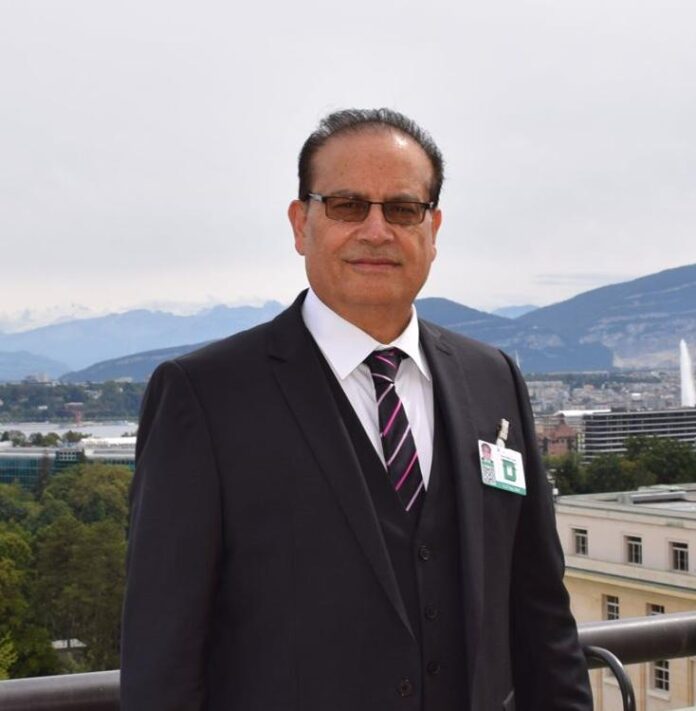By Qamar Bashir
A chilling shadow has once again fallen over the Earth. After his meeting with South Korean leadership, President Donald Trump issued a startling directive to the United States military establishment—to restart nuclear testing after decades of restraint. The announcement, largely overlooked by many journalists and analysts, carries immense consequences for global peace, environmental stability, and the very survivability of humankind.
Trump’s latest declaration on social media left little ambiguity. He boasted that the United States possesses “so much nuclear power that it can destroy the world 150 times over.” Though such a statement may sound like political bravado, its implications are profoundly serious. It signals the beginning of a new nuclear arms race—one likely to spiral beyond control.
Since the end of the Cold War, the world had enjoyed a fragile but essential consensus against nuclear testing. Treaties such as the Comprehensive Nuclear-Test-Ban Treaty (CTBT), although not ratified by all powers, represented a global moral understanding: nuclear weapons may exist, but they must never again be unleashed or tested. With Trump’s call to resume testing, that understanding has been shattered.
The rationale behind this order, according to senior U.S. defense sources, is to “ensure America’s nuclear readiness” in light of escalating tensions in Eastern Europe and the Pacific. The ongoing Russia–Ukraine war, the U.S.–China rivalry in the South China Sea, and North Korea’s persistent nuclear ambitions have created a climate of mutual suspicion. Yet by reigniting nuclear testing, the United States has effectively reopened Pandora’s box—inviting others to follow.
Trump’s announcement cannot be separated from Moscow’s growing anxiety. Russia today finds itself encircled by NATO’s military expansion, besieged by economic sanctions, and confronted by Western-backed forces in Ukraine. President Vladimir Putin, interpreting this as an existential threat, has responded in kind—ordering his own defense industry to “fine-tune, modernize, and reactivate” both strategic and tactical nuclear weapons.
For Russia, nuclear deterrence has once again become the last bastion of sovereignty. Putin’s rhetoric reflects not mere arrogance, but genuine alarm. Facing what he perceives as a united Western effort to dismantle Russia’s regional influence, he has signaled readiness to escalate—reviving Cold War-era nuclear doctrine that views atomic weapons as instruments of both defense and coercion.
If Trump follows through on his directive, nuclear tests would likely resume at long-dormant sites in the American deserts—such as Nevada or New Mexico—or possibly in new offshore facilities. But each test, no matter how contained, releases radiation, destabilizes local geology, and leaves irreversible scars on ecosystems. Underground detonations fracture rock layers and contaminate aquifers, while atmospheric tests eject radioactive isotopes into the jet stream, spreading silent poison across continents.
Even so-called “low-yield” or “controlled” tests can emit deadly isotopes like cesium-137 and strontium-90, which linger in the environment for decades. The shockwaves alone are enough to damage fragile habitats, destroy marine life near coastal testing sites, and accelerate the degradation of already threatened ecosystems.
In the era of COP climate summits, where nations convene to curb emissions and reduce environmental damage, the idea of reviving nuclear tests borders on ecological insanity. Each detonation negates years of progress in reducing carbon footprints and combating global warming. Nuclear tests not only pollute air, water, and soil—they symbolically announce that the military might once again supersede environmental stewardship.
The strategic consequence of the U.S. decision is perhaps even more dangerous than its environmental one. Once Washington resumes testing, other nuclear powers will inevitably follow. Russia and China will not allow the United States to hold exclusive technological advantage. India and Pakistan, already uneasy neighbors, may feel compelled to upgrade and validate their arsenals. Even “undeclared” nuclear states like Israel and North Korea could exploit the situation to justify fresh tests under the pretext of “national security.”
This domino effect risks dismantling decades of non-proliferation progress. The nuclear genie, once unleashed again, will not be confined. Each new test brings humanity closer to normalizing the idea of nuclear use—something the post-1945 world has spent generations trying to prevent.
Trump’s nuclear rhetoric also fits within a pattern of psychological warfare—a deliberate attempt to intimidate adversaries and reassert American supremacy. His claim that the United States is “25 years ahead of China and Russia” in nuclear technology may be partially true, but it is equally reckless. Both Moscow and Beijing view such statements not as confidence but as provocation.
China, in particular, has been rapidly advancing its own nuclear triad—modernizing land-based missiles, submarines, and air-launched systems. By Trump’s own admission, “they are catching up fast.” Yet instead of engaging in strategic arms reduction or renewed diplomacy, the U.S. president appears intent on accelerating the race. The result: a spiral of suspicion, investment, and escalation that risks undoing half a century of arms-control achievements.
Beyond politics, the return of nuclear testing poses a direct threat to planetary survival. Humanity already faces mounting crises—climate change, biodiversity collapse, rising sea levels, and environmental degradation. Nuclear testing adds yet another existential burden.
Each underground blast alters the Earth’s crust; each atmospheric detonation releases radioactive debris that can circulate for generations. The cost is not limited to those near the testing zones—radioactive particles carried by winds can contaminate distant farmlands and oceans, threatening global food chains and health systems.
Scientific studies from previous testing eras reveal that even low-level exposure has measurable genetic effects—birth defects, cancer risks, and DNA mutations—on both human and animal populations. To knowingly revive this hazard for geopolitical theatrics is a betrayal of both science and morality.
The international community must not remain silent. The United Nations, the International Atomic Energy Agency, and leading environmental organizations must urgently convene to prevent this reckless revival of nuclear testing. The scientific community must speak out with data, clarity, and conviction. World leaders—from Europe to Asia, from Africa to Latin America—must recognize that silence in the face of nuclear escalation is complicity.
The lesson of Hiroshima and Nagasaki was meant to be final: that no nation, no leader, and no ideology should ever gamble with the survival of the planet. Yet here we are again, standing at the edge of history, where one man’s command could unmake decades of peace and poison the very Earth that sustains us.
Human civilization must now choose between two paths—one paved by fear and destruction, the other by restraint and wisdom. For if the atomic fire is rekindled, it may not burn just deserts or oceans—it may consume the very soul of humanity.
By Qamar Bashir
Press Secretary to the President (Rtd)
Former Press Minister, Embassy of Pakistan to France
Former Press Attaché to Malaysia
Former MD, SRBC | Macomb, Michigan, USA

















